The effects of “flare” - and it's not pretty...
We are no longer building saddle trees, but we have two videos about how Western saddles fit horses available on our westernsaddlefit.com website.
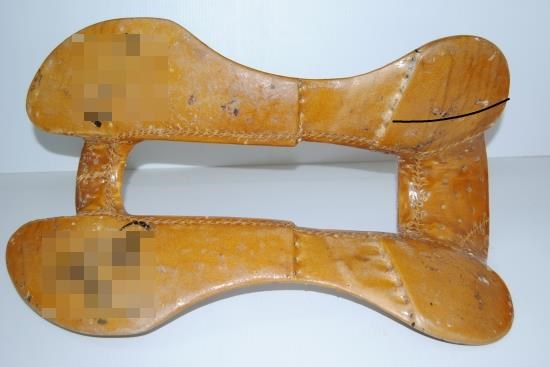
Just over a year ago, we put up a post on “flare” – the idea that you curve out the front of the tree bars a lot so that it doesn’t contact the horse, essentially giving the front of the bars excess rock compared to the shape of the horse. The theory is that the shoulder blade is then free to rotate backward without pressure as the horse extends its leg. We disagree with this theory and explained our reasoning in that post, saying that the saddle would move forward and actually cause the problems that “flare” was supposed to present. Well, we now have a real life example to share with you of how “flare” works out in the real world.
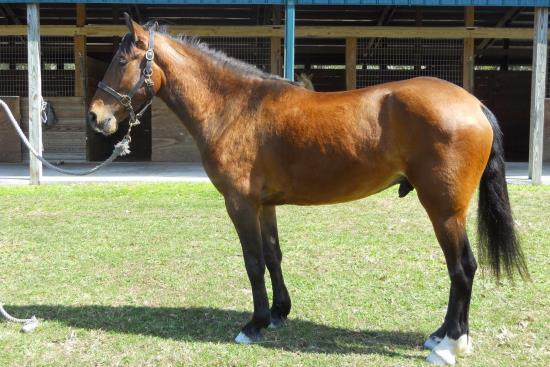
A couple of months ago we were discussing this horse with his owner. The history is that this is a 2006 mustang which the owner has had since he was 2 ½ years old. She commented “He has always had dips behind his shoulders, even as a 2-1/2 year old wild mustang.” Here is a picture of him from February 2010 as a 3 ½ year old.
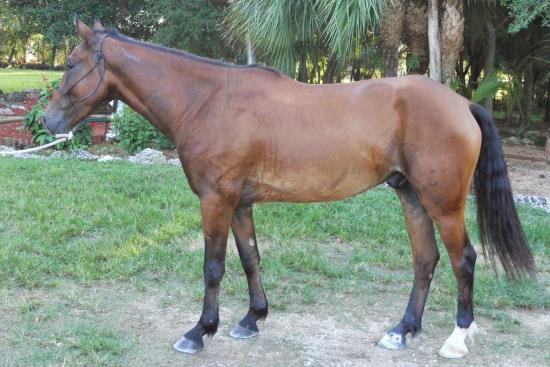
And in July of 2010 as an almost 4 year old after he had lost weight. (This picture also shows that he has very little rock in his back. He really is quite flat backed compared to a lot of horses. He has remained this way, even as he has matured.)
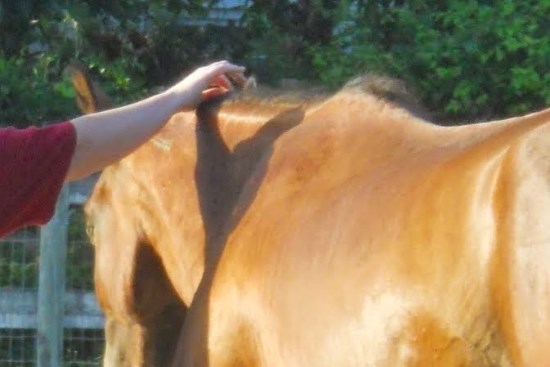
This picture is also from July 2010, but taken from an angle. Yes, he is a narrow horse with naturally concave wither pockets, but at this point he has the smooth transition from wither pocket area to shoulder blade that we see with the normal wither conformation which we discussed in a previous blog post.
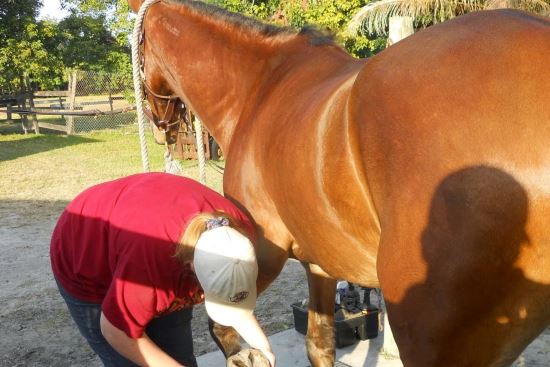
Here he is in January of 2011, after he gained some weight back. Even with his foot picked up, which affects the way the shoulder blade sits against the body, you can see the smooth transition from wither pocket to shoulder.
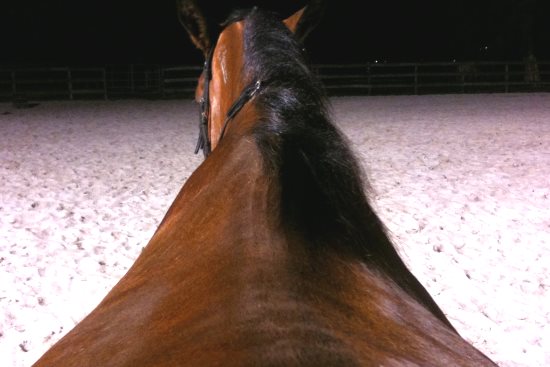
The first picture we have from directly behind was taken in February 2011. It’s not the best picture, but you can still see the concave wither area smoothly curving out over the wider shoulder blades.
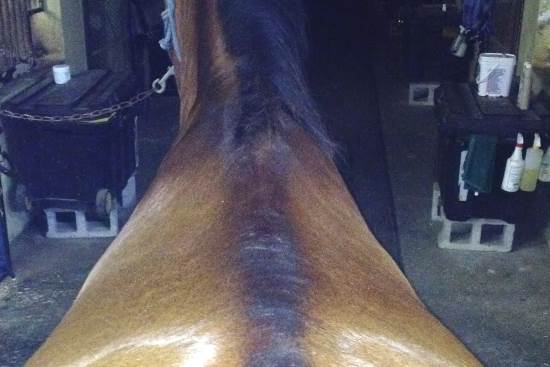
And another picture from May of 2012. Still concave wither pocket area. Still smooth transition. At this point, the owner was wanting a better saddle so, wanting to get the best saddle she could for her horse, she researched and contacted a reputable tack shop.
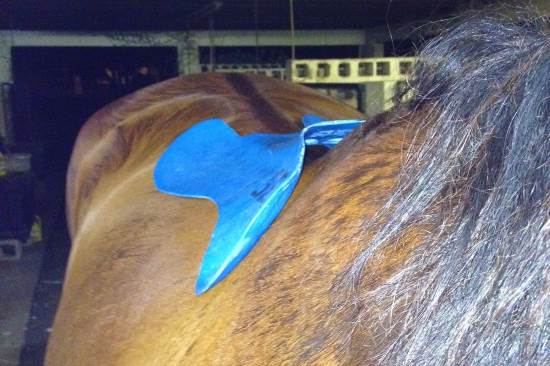
This is the style of tree they recommended for her horse. This is a form from a major production tree company that people can use to see how well that company's different tree conformations will fit their horse. This is their mule fit – flatter backed and with a steeper wither angle, which makes sense for this horse. But… this tree also follows the idea of having “flare” to make room for the shoulder blades. When I asked why that tree was chosen, she said “The person I was ordering the saddle through helped me choose that one after looking at pictures of the forms I had narrowed it down to.” Having “flare” is a common saddle fit theory and a lot of tack shops promote it.
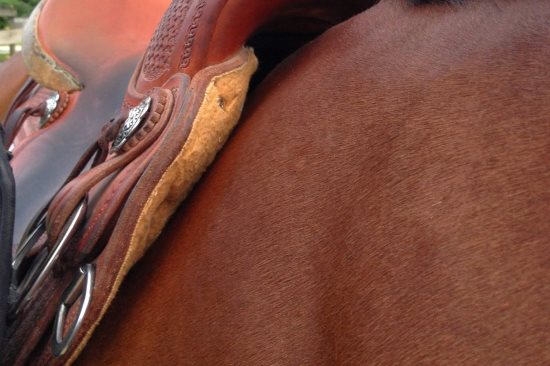
Here’s the final saddle placed on the horse with no padding, taken in June of 2013 after about a year of use. Usually looking at pictures like this doesn’t give lots of information because so often all you can see are the skirts of the saddle, and the skirts may or may not follow the bar, depending if they have been blocked to the bars or not, or how well they have been blocked. But in this case you can see the curve of the bar extending away from the horse, just like the form did.
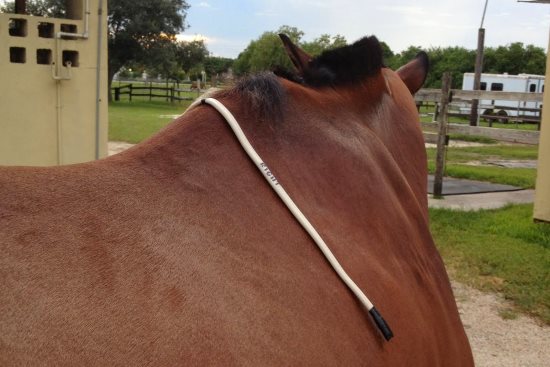
This picture was also taken in June of 2013. About a year of riding pretty much exclusively in this saddle, and you are already seeing a steeper transition zone from the shoulder to the wither pocket and a bit of a lump at the back of the shoulder blade.
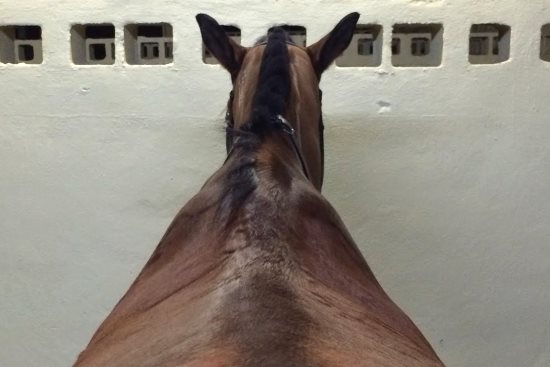
And by March of 2015, this is the horse’s back.
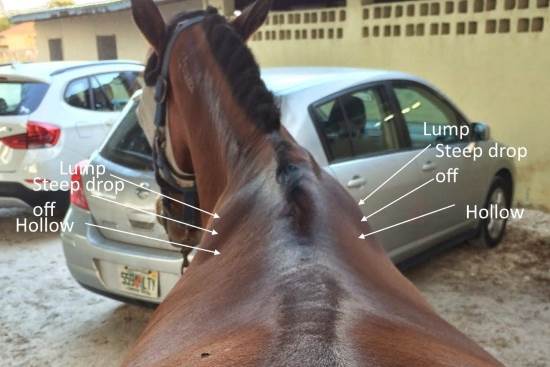
In fact, this is the horse we used as our poster child for the “lump and hollow” effect we see with damage resulting from muscle being compressed between bar and bone at the back of the shoulder blade. What happened? There was so much room there!!
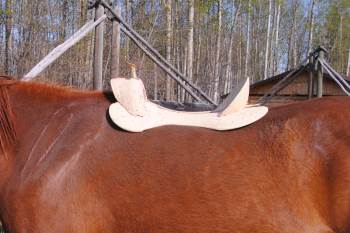 |
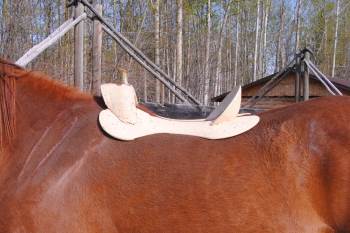 |
Here are the pictures we posted before, showing where the tree with “flare” was supposed to be positioned, and where it actually matched the shapes the best. And, like in our cutlery example, trees go to where the shapes match if at all possible.
In our conversations with this owner, we talked about position of the saddle and she was very aware that the saddle needs to be placed with the front bar tip behind the shoulder blade. However, she said “This saddle tends to work its way forward from the position I put it in when I start out... Also I have never had an issue with this saddle slipping side to side; my cinch always ends up loose by the time I'm done riding.” So the saddle isn’t sloppy on the horse, as a too-wide saddle would be, but it goes forward – up to where the shape of the bar fits the shape of the horse.
Like we have said before, the reason the western saddle bar can fit up to the back of the shoulder blade is because when the shoulder blade rotates back, it does so when there is no weight on the leg. Because there is no bony attachment between the front leg and the torso, that back corner can slip in under the front bar tip at full extension - given that there is enough relief built into that front bar tip and that the skirts are blocked well so they don’t jab the shoulder blade. But there is no pressure on the muscle overlying the shoulder blade at that point because there is no weight on the leg. By the time the leg is weighted again, the shoulder blade is back out from underneath the bar. But if the bar is over the shoulder blade when there is weight on the leg, you get high pressure and muscle damage. And that is what has happened here.
(As an aside, the owner also commented that other saddles she has tried for single rides also tend to move forward on this horse, but that may be because the majority of saddles today would be far too wide for this narrow a horse.)
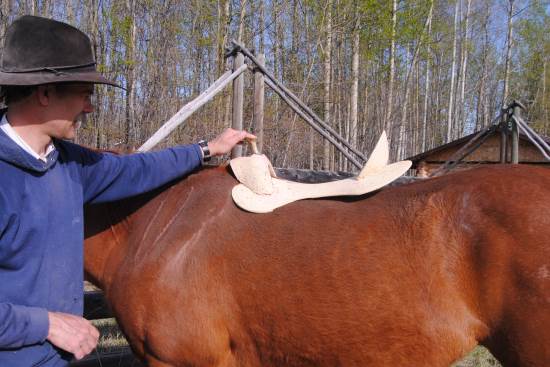
All this was despite the owner using shims at the front of the bars to hold it up. She said that unless she used the shims, she always felt tipped forward. This makes sense, because again, what having excess “flare” means practically is that you have too much rock in the tree for the horse’s shape.
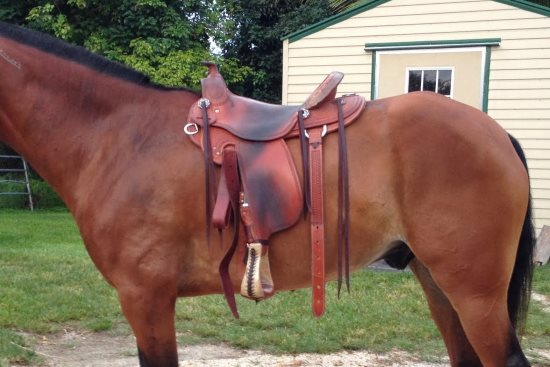
So although the saddle looks good on the horse, not tilted downhill and lifting up at the back when just sitting there, when it gets used, the effects of that excess rock show – by tilting the rider forward.
All of the above statements from the owner came before we commented on what we were seeing, so there was no leading her on to make these statements. This is straight out fact, from the owner’s viewpoint, of what was happening as she rode this saddle on her horse. After we gave her our comments and referred her to the “flare” post, she then said “I had read your article about flare in the past, but it was good to read it again. The saddle has what I think you would call a flat plate rigging probably in a 7/8 position. When cinched up and standing still, the saddle looks okay, but if I were to lunge him in a few circles at a trot, the back starts bouncing, even if I use the back cinch.” This again is one of the effects of too much rock – the saddle lifting up at the back.
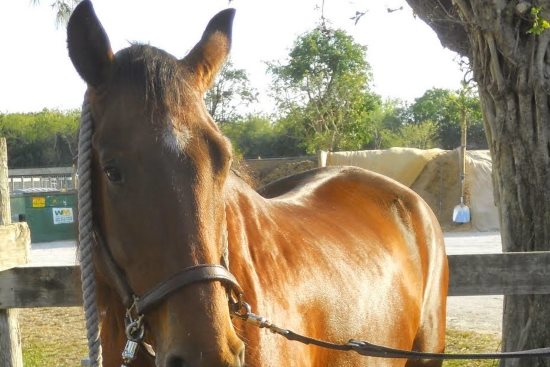
So there you go. From this in 2011...
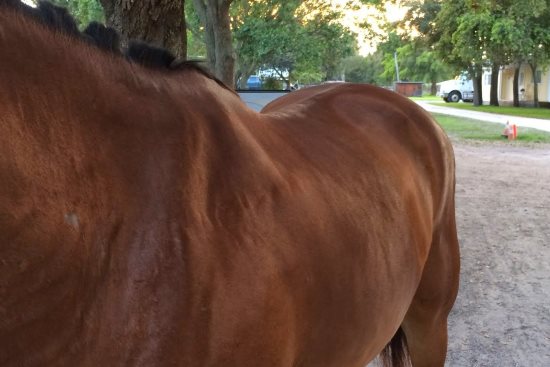
to this in 2015, all primarily because of the idea that we need to "flare" out the front of the bars to help the horse. Sounds like such a good idea, but in practice, it just doesn’t work. In fact, it harms them...
Note: We have since done some pressure studies that tell us that our ideas are correct, and that the industry needs to rethink the ideas about saddle fit and shoulder movement. The whole concept of "flare" isn't needed at all.
